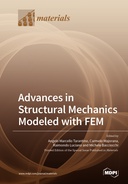Explore

Advances in Structural Mechanics Modeled with FEM
0 Ungluers have
Faved this Work
Login to Fave
It is well known that many structural and physical problems cannot be solved by analytical approaches. These problems require the development of numerical methods to get approximate but accurate solutions. The minite element method (FEM) represents one of the most typical methodologies that can be used to achieve this aim, due to its simple implementation, easy adaptability, and very good accuracy. For these reasons, the FEM is a widespread technique which is employed in many engineering fields, such as civil, mechanical, and aerospace engineering. The large-scale deployment of powerful computers and the consequent recent improvement of the computational resources have provided the tools to develop numerical approaches that are able to solve more complex structural systems characterized by peculiar mechanical configurations. Laminated or multi-phase composites, structures made of innovative materials, and nanostructures are just some examples of applications that are commonly and accurately solved by the FEM. Analogously, the same numerical approaches can be employed to validate the results of experimental tests. The main aim of this Special Issue is to collect numerical investigations focused on the use of the finite element method
This book is included in DOAB.
Why read this book? Have your say.
You must be logged in to comment.
Rights Information
Are you the author or publisher of this work? If so, you can claim it as yours by registering as an Unglue.it rights holder.Downloads
This work has been downloaded 96 times via unglue.it ebook links.
- 96 - pdf (CC BY) at Unglue.it.
Keywords
- 3D elasticity
- acoustic black holes
- acoustic-oriented design
- additive manufacturing
- beam element
- bond–slip
- bowing
- carbon nanotubes
- coalbed methane
- cohesive zone model
- compactness index
- composite
- Convergence
- crack band
- dual-porosity and dual-permeability media
- effective stiffness matrix
- Elastica
- Eulerian slenderness
- FEM
- FGM
- finite bending
- Finite element
- finite element analysis
- Finite element method
- finite element modeling
- Finite elements
- flexural behavior
- fracture geometric parameters
- free vibrations
- FRP
- functionally graded beam
- geometric nonlinearity
- hollow circular beams
- impact loading
- implementation
- machine tool
- masonry
- material parameter identification
- material-oriented shape functions
- mesh sensitivity
- model order reduction
- Monte Carlo method
- multibody system
- n/a
- NURBS
- orthotropic failure criteria
- Plasticity
- plate
- post-peak softening
- pultruded beams
- Quasi-3D
- rate-dependent
- Reference, information & interdisciplinary subjects
- Reinforced concrete
- Research & information: general
- rigid finite element method
- sandwich plates
- Searle parameter
- soda-lime glass
- static bending
- steel-polymer concrete
- stochastic fracture network
- strain localization
- Technology, engineering, agriculture
- Technology: general issues
- thermoelasticity
- three-phase composite materials
- transient heat flux
- Vibroacoustics
- viscoplastic regularization
- zig-zag theory
Links
DOI: 10.3390/books978-3-0365-0991-4Editions

